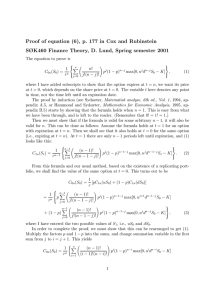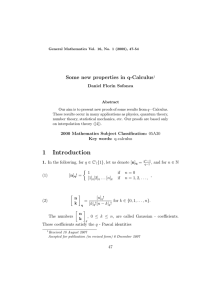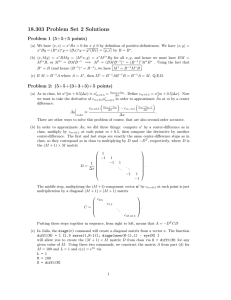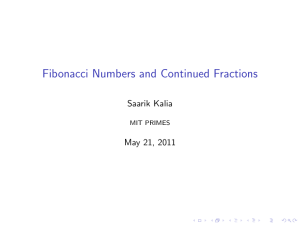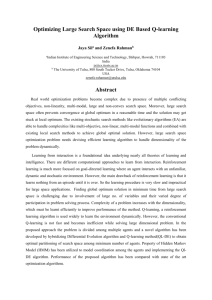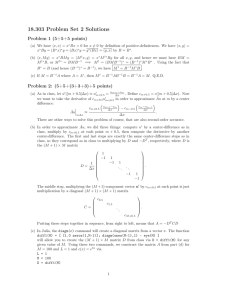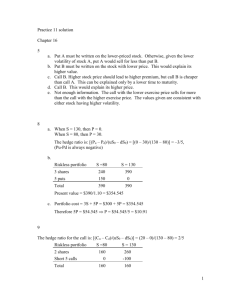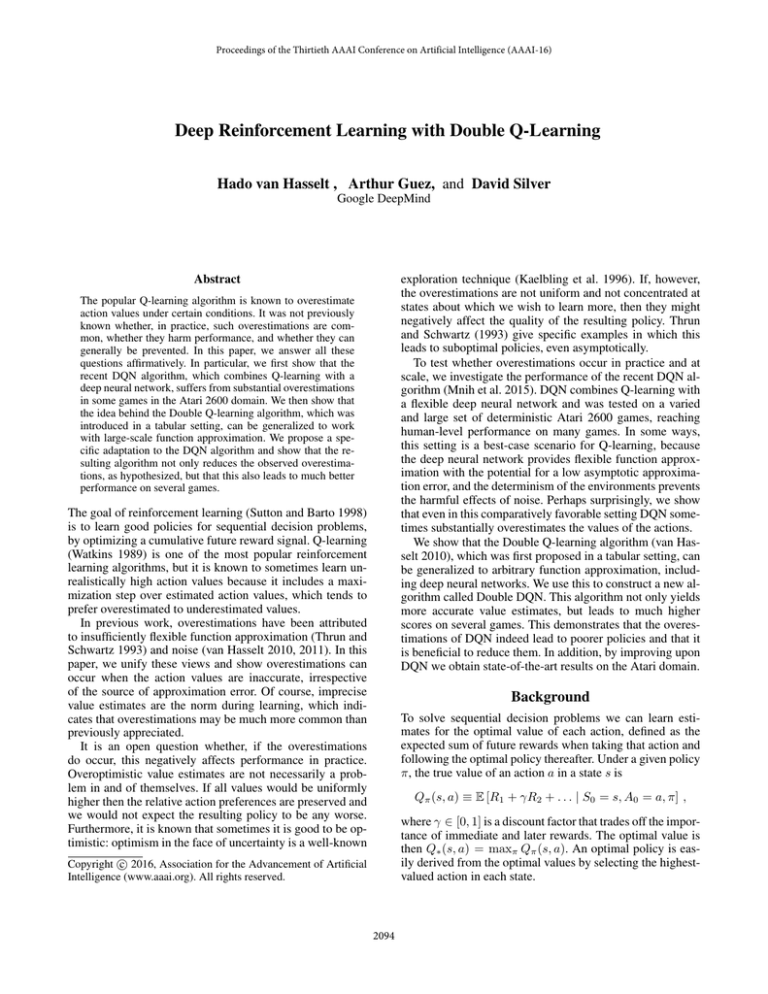
Proceedings of the Thirtieth AAAI Conference on Artificial Intelligence (AAAI-16)
Deep Reinforcement Learning with Double Q-Learning
Hado van Hasselt , Arthur Guez, and David Silver
Google DeepMind
exploration technique (Kaelbling et al. 1996). If, however,
the overestimations are not uniform and not concentrated at
states about which we wish to learn more, then they might
negatively affect the quality of the resulting policy. Thrun
and Schwartz (1993) give specific examples in which this
leads to suboptimal policies, even asymptotically.
To test whether overestimations occur in practice and at
scale, we investigate the performance of the recent DQN algorithm (Mnih et al. 2015). DQN combines Q-learning with
a flexible deep neural network and was tested on a varied
and large set of deterministic Atari 2600 games, reaching
human-level performance on many games. In some ways,
this setting is a best-case scenario for Q-learning, because
the deep neural network provides flexible function approximation with the potential for a low asymptotic approximation error, and the determinism of the environments prevents
the harmful effects of noise. Perhaps surprisingly, we show
that even in this comparatively favorable setting DQN sometimes substantially overestimates the values of the actions.
We show that the Double Q-learning algorithm (van Hasselt 2010), which was first proposed in a tabular setting, can
be generalized to arbitrary function approximation, including deep neural networks. We use this to construct a new algorithm called Double DQN. This algorithm not only yields
more accurate value estimates, but leads to much higher
scores on several games. This demonstrates that the overestimations of DQN indeed lead to poorer policies and that it
is beneficial to reduce them. In addition, by improving upon
DQN we obtain state-of-the-art results on the Atari domain.
Abstract
The popular Q-learning algorithm is known to overestimate
action values under certain conditions. It was not previously
known whether, in practice, such overestimations are common, whether they harm performance, and whether they can
generally be prevented. In this paper, we answer all these
questions affirmatively. In particular, we first show that the
recent DQN algorithm, which combines Q-learning with a
deep neural network, suffers from substantial overestimations
in some games in the Atari 2600 domain. We then show that
the idea behind the Double Q-learning algorithm, which was
introduced in a tabular setting, can be generalized to work
with large-scale function approximation. We propose a specific adaptation to the DQN algorithm and show that the resulting algorithm not only reduces the observed overestimations, as hypothesized, but that this also leads to much better
performance on several games.
The goal of reinforcement learning (Sutton and Barto 1998)
is to learn good policies for sequential decision problems,
by optimizing a cumulative future reward signal. Q-learning
(Watkins 1989) is one of the most popular reinforcement
learning algorithms, but it is known to sometimes learn unrealistically high action values because it includes a maximization step over estimated action values, which tends to
prefer overestimated to underestimated values.
In previous work, overestimations have been attributed
to insufficiently flexible function approximation (Thrun and
Schwartz 1993) and noise (van Hasselt 2010, 2011). In this
paper, we unify these views and show overestimations can
occur when the action values are inaccurate, irrespective
of the source of approximation error. Of course, imprecise
value estimates are the norm during learning, which indicates that overestimations may be much more common than
previously appreciated.
It is an open question whether, if the overestimations
do occur, this negatively affects performance in practice.
Overoptimistic value estimates are not necessarily a problem in and of themselves. If all values would be uniformly
higher then the relative action preferences are preserved and
we would not expect the resulting policy to be any worse.
Furthermore, it is known that sometimes it is good to be optimistic: optimism in the face of uncertainty is a well-known
Background
To solve sequential decision problems we can learn estimates for the optimal value of each action, defined as the
expected sum of future rewards when taking that action and
following the optimal policy thereafter. Under a given policy
π, the true value of an action a in a state s is
Qπ (s, a) ≡ E [R1 + γR2 + . . . | S0 = s, A0 = a, π] ,
where γ ∈ [0, 1] is a discount factor that trades off the importance of immediate and later rewards. The optimal value is
then Q∗ (s, a) = maxπ Qπ (s, a). An optimal policy is easily derived from the optimal values by selecting the highestvalued action in each state.
c 2016, Association for the Advancement of Artificial
Copyright Intelligence (www.aaai.org). All rights reserved.
2094
Notice that the selection of the action, in the argmax, is
still due to the online weights θt . This means that, as in Qlearning, we are still estimating the value of the greedy policy according to the current values, as defined by θt . However, we use the second set of weights θt to fairly evaluate
the value of this policy. This second set of weights can be
updated symmetrically by switching the roles of θ and θ .
Estimates for the optimal action values can be learned
using Q-learning (Watkins 1989), a form of temporal difference learning (Sutton 1988). Most interesting problems
are too large to learn all action values in all states separately. Instead, we can learn a parameterized value function
Q(s, a; θt ). The standard Q-learning update for the parameters after taking action At in state St and observing the
immediate reward Rt+1 and resulting state St+1 is then
Overoptimism due to estimation errors
θt+1 = θt +α(YtQ −Q(St , At ; θt ))∇θt Q(St , At ; θt ) . (1)
Q-learning’s overestimations were first investigated by
Thrun and Schwartz (1993), who showed that if the action
values contain random errors uniformly distributed in an interval [−, ] then each target is overestimated up to γ m−1
m+1 ,
where m is the number of actions. In addition, Thrun and
Schwartz give a concrete example in which these overestimations even asymptotically lead to sub-optimal policies,
and show the overestimations manifest themselves in a small
toy problem when using function approximation. Van Hasselt (2010) noted that noise in the environment can lead to
overestimations even when using tabular representation, and
proposed Double Q-learning as a solution.
In this section we demonstrate more generally that estimation errors of any kind can induce an upward bias, regardless of whether these errors are due to environmental
noise, function approximation, non-stationarity, or any other
source. This is important, because in practice any method
will incur some inaccuracies during learning, simply due to
the fact that the true values are initially unknown.
The result by Thrun and Schwartz (1993) cited above
gives an upper bound to the overestimation for a specific
setup, but it is also possible, and potentially more interesting, to derive a lower bound.
where α is a scalar step size and the target YtQ is defined as
YtQ ≡ Rt+1 + γ max Q(St+1 , a; θt ) .
a
(2)
This update resembles stochastic gradient descent, updating
the current value Q(St , At ; θt ) towards a target value YtQ .
Deep Q Networks
A deep Q network (DQN) is a multi-layered neural network
that for a given state s outputs a vector of action values
Q(s, · ; θ), where θ are the parameters of the network. For
an n-dimensional state space and an action space containing m actions, the neural network is a function from Rn to
Rm . Two important ingredients of the DQN algorithm as
proposed by Mnih et al. (2015) are the use of a target network, and the use of experience replay. The target network,
with parameters θ − , is the same as the online network except that its parameters are copied every τ steps from the
online network, so that then θt− = θt , and kept fixed on all
other steps. The target used by DQN is then
YtDQN ≡ Rt+1 + γ max Q(St+1 , a; θt− ) .
a
(3)
For the experience replay (Lin 1992), observed transitions
are stored for some time and sampled uniformly from this
memory bank to update the network. Both the target network
and the experience replay dramatically improve the performance of the algorithm (Mnih et al. 2015).
Theorem 1. Consider a state s in which all the true optimal
action values are equal at Q∗ (s, a) = V∗ (s) for some V∗ (s).
Let Qt be arbitrary valueestimates that are on the whole unbiased in the sense that a (Qt
(s, a) − V∗ (s)) = 0, but that
1
2
are not all correct, such that m
a (Qt (s, a)−V∗ (s)) = C
for some C > 0, where m ≥ 2 is the number of actions
in s.
C
.
Under these conditions, maxa Qt (s, a) ≥ V∗ (s) + m−1
This lower bound is tight. Under the same conditions, the
lower bound on the absolute error of the Double Q-learning
estimate is zero. (Proof in appendix.)
Double Q-learning
The max operator in standard Q-learning and DQN, in (2)
and (3), uses the same values both to select and to evaluate
an action. This makes it more likely to select overestimated
values, resulting in overoptimistic value estimates. To prevent this, we can decouple the selection from the evaluation.
In Double Q-learning (van Hasselt 2010), two value functions are learned by assigning experiences randomly to update one of the two value functions, resulting in two sets of
weights, θ and θ . For each update, one set of weights is
used to determine the greedy policy and the other to determine its value. For a clear comparison, we can untangle the
selection and evaluation in Q-learning and rewrite its target
(2) as
Note that we did not need to assume that estimation errors
for different actions are independent. This theorem shows
that even if the value estimates are on average correct, estimation errors of any source can drive the estimates up and
away from the true optimal values.
The lower bound in Theorem 1 decreases with the number of actions. This is an artifact of considering the lower
bound, which requires very specific values to be attained.
More typically, the overoptimism increases with the number of actions as shown in Figure 1. Q-learning’s overestimations there indeed increase with the number of actions,
while Double Q-learning is unbiased. As another example,
if for all actions Q∗ (s, a) = V∗ (s) and the estimation errors
Qt (s, a) − V∗ (s) are uniformly random in [−1, 1], then the
overoptimism is m−1
m+1 . (Proof in appendix.)
YtQ = Rt+1 + γQ(St+1 , argmax Q(St+1 , a; θt ); θt ) .
a
The Double Q-learning error can then be written as
YtDoubleQ ≡ Rt+1 + γQ(St+1 , argmax Q(St+1 , a; θt ); θt ) .
a
(4)
2095
error
1.5
Q-learning in blue2 , which are on average much closer to
zero. This demonstrates that Double Q-learning indeed can
successfully reduce the overoptimism of Q-learning.
The different rows in Figure 2 show variations of the same
experiment. The difference between the top and middle rows
is the true value function, demonstrating that overestimations are not an artifact of a specific true value function.
The difference between the middle and bottom rows is the
flexibility of the function approximation. In the left-middle
plot, the estimates are even incorrect for some of the sampled states because the function is insufficiently flexible.
The function in the bottom-left plot is more flexible but this
causes higher estimation errors for unseen states, resulting
in higher overestimations. This is important because flexible parametric function approximation is often employed in
reinforcement learning (see, e.g., Tesauro 1995, Sallans and
Hinton 2004, Riedmiller 2005, and Mnih et al. 2015).
In contrast to van Hasselt (2010), we did not use a statistical argument to find overestimations, the process to obtain Figure 2 is fully deterministic. In contrast to Thrun and
Schwartz (1993), we did not rely on inflexible function approximation with irreducible asymptotic errors; the bottom
row shows that a function that is flexible enough to cover all
samples leads to high overestimations. This indicates that
the overestimations can occur quite generally.
In the examples above, overestimations occur even when
assuming we have samples of the true action value at certain states. The value estimates can further deteriorate if we
bootstrap off of action values that are already overoptimistic,
since this causes overestimations to propagate throughout
our estimates. Although uniformly overestimating values
might not hurt the resulting policy, in practice overestimation errors will differ for different states and actions. Overestimation combined with bootstrapping then has the pernicious effect of propagating the wrong relative information
about which states are more valuable than others, directly
affecting the quality of the learned policies.
The overestimations should not be confused with optimism in the face of uncertainty (Sutton 1990, Agrawal 1995,
Kaelbling et al. 1996, Auer at al. 2002, Brafman and Tennenholtz 2003, Szita and Lõrincz 2008, Strehl and Littman
2009), where an exploration bonus is given to states or actions with uncertain values. The overestimations discussed
here occur only after updating, resulting in overoptimism in
the face of apparent certainty. Thrun and Schwartz (1993)
noted that, in contrast to optimism in the face of uncertainty,
these overestimations actually can impede learning an optimal policy. We confirm this negative effect on policy quality
in our experiments: when we reduce the overestimations using Double Q-learning, the policies improve.
maxa Q(s, a) − V∗ (s)
Q (s, argmaxa Q(s, a)) − V∗ (s)
1.0
0.5
0.0
24
10
2
51
6
25
8
12
64
32
16
8
4
2
number of actions
Figure 1: The orange bars show the bias in a single Qlearning update when the action values are Q(s, a) =
V∗ (s) + a and the errors {a }m
a=1 are independent standard
normal random variables. The second set of action values
Q , used for the blue bars, was generated identically and independently. All bars are the average of 100 repetitions.
We now turn to function approximation and consider a
real-valued continuous state space with 10 discrete actions
in each state. For simplicity, the true optimal action values
in this example depend only on state so that in each state
all actions have the same true value. These true values are
shown in the left column of plots in Figure 2 (purple lines)
and are defined as either Q∗ (s, a) = sin(s) (top row) or
Q∗ (s, a) = 2 exp(−s2 ) (middle and bottom rows). The left
plots also show an approximation for a single action (green
lines) as a function of state as well as the samples the estimate is based on (green dots). The estimate is a d-degree
polynomial that is fit to the true values at sampled states,
where d = 6 (top and middle rows) or d = 9 (bottom
row). The samples match the true function exactly: there is
no noise and we assume we have ground truth for the action
value on these sampled states. The approximation is inexact even on the sampled states for the top two rows because
the function approximation is insufficiently flexible. In the
bottom row, the function is flexible enough to fit the green
dots, but this reduces the accuracy in unsampled states. Notice that the sampled states are spaced further apart near the
left side of the left plots, resulting in larger estimation errors.
In many ways this is a typical learning setting, where at each
point in time we only have limited data.
The middle column of plots in Figure 2 shows estimated
action values for all 10 actions (green lines), as functions
of state, along with the maximum action value in each state
(black dashed line). Although the true value function is the
same for all actions, the approximations differ because they
are based on different sets of sampled states.1 The maximum
is often higher than the ground truth shown in purple on the
left. This is confirmed in the right plots, which shows the difference between the black and purple curves in orange. The
orange line is almost always positive, indicating an upward
bias. The right plots also show the estimates from Double
Double DQN
The idea of Double Q-learning is to reduce overestimations
by decomposing the max operation in the target into action
1
Each action-value function is fit with a different subset of integer states. States −6 and 6 are always included to avoid extrapolations, and for each action two adjacent integers are missing: for
action a1 states −5 and −4 are not sampled, for a2 states −4 and
−3 are not sampled, and so on. This causes the estimated values to
differ.
We arbitrarily used the samples of action ai+5 (for i ≤ 5)
or ai−5 (for i > 5) as the second set of samples for the double
estimator of action ai .
2
2096
True value and an estimate
All estimates and max
2
2
Q∗ (s, a)
0
−2
Bias as function of state
maxa Qt (s, a)
0
Qt (s, a)
maxa Qt (s, a)
2
4
Qt (s, a)
4
maxa Qt (s, a)
2
2
2
0
0
0
0
2
4
6
state
+0.02
Double-Q estimate
−1
0
Q∗ (s, a)
−4 −2
+0.47
0
0
−6
maxa Qt (s, a) − maxa Q∗ (s, a)
1
Qt (s, a)
4
Double-Q estimate
−1
−6
−4
−2
0
2
4
state
6
+0.61
−0.02
0
−2
Q∗ (s, a)
2
Average error
maxa Qt (s, a) − maxa Q∗ (s, a)
1
maxa Qt (s, a)−
maxa Q∗ (s, a)
+3.35
−6
−4
Double-Q estimate
−2
0
2
4
−0.02
6
state
Figure 2: Illustration of overestimations during learning. In each state (x-axis), there are 10 actions. The left column shows the
true values V∗ (s) (purple line). All true action values are defined by Q∗ (s, a) = V∗ (s). The green line shows estimated values
Q(s, a) for one action as a function of state, fitted to the true value at several sampled states (green dots). The middle column
plots show all the estimated values (green), and the maximum of these values (dashed black). The maximum is higher than the
true value (purple, left plot) almost everywhere. The right column plots shows the difference in orange. The blue line in the
right plots is the estimate used by Double Q-learning with a second set of samples for each state. The blue line is much closer to
zero, indicating less bias. The three rows correspond to different true functions (left, purple) or capacities of the fitted function
(left, green). (Details in the text)
goal is for a single algorithm, with a fixed set of hyperparameters, to learn to play each of the games separately from
interaction given only the screen pixels as input. This is a demanding testbed: not only are the inputs high-dimensional,
the game visuals and game mechanics vary substantially between games. Good solutions must therefore rely heavily
on the learning algorithm — it is not practically feasible to
overfit the domain by relying only on tuning.
We closely follow the experimental setup and network architecture used by Mnih et al. (2015). Briefly, the network
architecture is a convolutional neural network (Fukushima
1988, Lecun et al. 1998) with 3 convolution layers and a
fully-connected hidden layer (approximately 1.5M parameters in total). The network takes the last four frames as input
and outputs the action value of each action. On each game,
the network is trained on a single GPU for 200M frames.
selection and action evaluation. Although not fully decoupled, the target network in the DQN architecture provides
a natural candidate for the second value function, without
having to introduce additional networks. We therefore propose to evaluate the greedy policy according to the online
network, but using the target network to estimate its value.
In reference to both Double Q-learning and DQN, we refer
to the resulting algorithm as Double DQN. Its update is the
same as for DQN, but replacing the target YtDQN with
YtDoubleDQN ≡ Rt+1 + γQ(St+1 , argmax Q(St+1 , a; θt ), θt− ) .
a
In comparison to Double Q-learning (4), the weights of the
second network θt are replaced with the weights of the target network θt− for the evaluation of the current greedy policy. The update to the target network stays unchanged from
DQN, and remains a periodic copy of the online network.
This version of Double DQN is perhaps the minimal possible change to DQN towards Double Q-learning. The goal
is to get most of the benefit of Double Q-learning, while
keeping the rest of the DQN algorithm intact for a fair comparison, and with minimal computational overhead.
Results on overoptimism
Figure 3 shows examples of DQN’s overestimations in six
Atari games. DQN and Double DQN were both trained under the exact conditions described by Mnih et al. (2015).
DQN is consistently and sometimes vastly overoptimistic
about the value of the current greedy policy, as can be seen
by comparing the orange learning curves in the top row of
plots to the straight orange lines, which represent the actual discounted value of the best learned policy. More precisely, the (averaged) value estimates are computed regularly during training with full evaluation phases of length
T = 125, 000 steps as
Empirical results
In this section, we analyze the overestimations of DQN and
show that Double DQN improves over DQN both in terms of
value accuracy and in terms of policy quality. To further test
the robustness of the approach we additionally evaluate the
algorithms with random starts generated from expert human
trajectories, as proposed by Nair et al. (2015).
Our testbed consists of Atari 2600 games, using the Arcade Learning Environment (Bellemare et al. 2013). The
T
1
argmax Q(St , a; θ) .
T t=1
a
2097
Value estimates
Alien
Space Invaders
Time Pilot
Zaxxon
2.5
20
8
8
2.0
6
1.5
4
1.0
2
15
6
Double DQN estimate
10
4
Value estimates
(log scale)
0
50 100 150 200
Double DQN true value
DQN true value
0
0
50 100 150 200
0
50 100 150 200
0 50 100 150 200
Training steps (in millions)
Wizard of Wor
Asterix
100
80
DQN
40
10
20
DQN
1
10
Double DQN
0
50
100
150
Double DQN
5
200
0
50
Wizard of Wor
100
150
200
Asterix
4000
Score
DQN estimate
Double DQN
6000
Double DQN
3000
4000
2000
2000
1000
DQN
DQN
0
0
0
50
100
150
200
0
Training steps (in millions)
50
100
150
200
Training steps (in millions)
Figure 3: The top and middle rows show value estimates by DQN (orange) and Double DQN (blue) on six Atari games. The
results are obtained by running DQN and Double DQN with 6 different random seeds with the hyper-parameters employed by
Mnih et al. (2015). The darker line shows the median over seeds and we average the two extreme values to obtain the shaded
area (i.e., 10% and 90% quantiles with linear interpolation). The straight horizontal orange (for DQN) and blue (for Double
DQN) lines in the top row are computed by running the corresponding agents after learning concluded, and averaging the actual
discounted return obtained from each visited state. These straight lines would match the learning curves at the right side of the
plots if there is no bias. The middle row shows the value estimates (in log scale) for two games in which DQN’s overoptimism
is quite extreme. The bottom row shows the detrimental effect of this on the score achieved by the agent as it is evaluated
during training: the scores drop when the overestimations begin. Learning with Double DQN is much more stable.
no ops
The ground truth averaged values are obtained by running
the best learned policies for several episodes and computing
the actual cumulative rewards. Without overestimations we
would expect these quantities to match up (i.e., the curve to
match the straight line at the right of each plot). Instead, the
learning curves of DQN consistently end up much higher
than the true values. The learning curves for Double DQN,
shown in blue, are much closer to the blue straight line representing the true value of the final policy. Note that the blue
straight line is often higher than the orange straight line. This
indicates that Double DQN does not just produce more accurate value estimates but also better policies.
DQN
DDQN
human starts
DQN
DDQN
DDQN
(tuned)
Median
Mean
93%
241%
115%
330%
47%
122%
88%
273%
117%
475%
Table 1: Summarized normalized performance on 49 games
for up to 5 minutes with up to 30 no ops at the start of each
episode, and for up to 30 minutes with randomly selected
human start points. Results for DQN are from Mnih et al.
(2015) (no ops) and Nair et al. (2015) (human starts).
More extreme overestimations are shown in the middle
two plots, where DQN is highly unstable on the games Asterix and Wizard of Wor. Notice the log scale for the values
on the y-axis. The bottom two plots shows the corresponding scores for these two games. Notice that the increases in
value estimates for DQN in the middle plots coincide with
decreasing scores in bottom plots. Again, this indicates that
the overestimations are harming the quality of the resulting
policies. If seen in isolation, one might perhaps be tempted
to think the observed instability is related to inherent instability problems of off-policy learning with function approximation (Baird 1995, Tsitsiklis and Van Roy 1997, Maei
2011, Sutton et al. 2015). However, we see that learning is
much more stable with Double DQN, suggesting that the
cause for these instabilities is in fact Q-learning’s overoptimism. Figure 3 only shows a few examples, but overestimations were observed for DQN in all 49 tested Atari games,
albeit in varying amounts.
Quality of the learned policies
Overoptimism does not always adversely affect the quality
of the learned policy. For example, DQN achieves optimal
2098
Video Pinball
Atlantis
Demon Attack
Breakout
Assault
Double Dunk
Robotank
Gopher
Boxing
Star Gunner
Road Runner
Krull
Crazy Climber
Kangaroo
Asterix
∗∗Defender∗∗
∗∗Phoenix∗∗
Up and Down
Space Invaders
James Bond
Enduro
Kung-Fu Master
Wizard of Wor
Name This Game
Time Pilot
Bank Heist
Beam Rider
Freeway
Pong
Zaxxon
Fishing Derby
Tennis
Q*Bert
∗∗Surround∗∗
River Raid
Battle Zone
Ice Hockey
Tutankham
H.E.R.O.
∗∗Berzerk∗∗
Seaquest
Chopper Command
Frostbite
∗∗Skiing∗∗
Bowling
Centipede
Alien
∗∗Yars Revenge∗∗
Amidar
Ms. Pacman
∗∗Pitfall∗∗
Asteroids
Montezuma’s Revenge
Venture
Gravitar
Private Eye
∗∗Solaris∗∗
Human
Double DQN (tuned)
Double DQN
DQN
%
0%
7500%
5000%
2500%
2000%
1500%
100%
500
%
400
%
300
%
200
0%
100
behavior in Pong despite slightly overestimating the policy
value. Nevertheless, reducing overestimations can significantly benefit the stability of learning; we see clear examples
of this in Figure 3. We now assess more generally how much
Double DQN helps in terms of policy quality by evaluating
on all 49 games that DQN was tested on.
As described by Mnih et al. (2015) each evaluation
episode starts by executing a special no-op action that does
not affect the environment up to 30 times, to provide different starting points for the agent. Some exploration during
evaluation provides additional randomization. For Double
DQN we used the exact same hyper-parameters as for DQN,
to allow for a controlled experiment focused just on reducing overestimations. The learned policies are evaluated
for 5 mins of emulator time (18,000 frames) with an greedy policy where = 0.05. The scores are averaged over
100 episodes. The only difference between Double DQN
and DQN is the target, using YtDoubleDQN rather than Y DQN .
This evaluation is somewhat adversarial, as the used hyperparameters were tuned for DQN but not for Double DQN.
To obtain summary statistics across games, we normalize
the score for each game as follows:
scoreagent − scorerandom
.
(5)
scorenormalized =
scorehuman − scorerandom
The ‘random’ and ‘human’ scores are the same as used by
Mnih et al. (2015), and are given in the appendix.
Table 1, under no ops, shows that on the whole Double
DQN clearly improves over DQN. A detailed comparison
(in appendix) shows that there are several games in which
Double DQN greatly improves upon DQN. Noteworthy examples include Road Runner (from 233% to 617%), Asterix
(from 70% to 180%), Zaxxon (from 54% to 111%), and
Double Dunk (from 17% to 397%).
The Gorila algorithm (Nair et al. 2015), which is a massively distributed version of DQN, is not included in the table because the architecture and infrastructure is sufficiently
different to make a direct comparison unclear. For completeness, we note that Gorila obtained median and mean normalized scores of 96% and 495%, respectively.
Normalized score
Figure 4: Normalized scores on 57 Atari games, tested
for 100 episodes per game with human starts. Compared
to Mnih et al. (2015), eight games additional games were
tested. These are indicated with stars and a bold font.
Robustness to Human starts
One concern with the previous evaluation is that in deterministic games with a unique starting point the learner could
potentially learn to remember sequences of actions without much need to generalize. While successful, the solution
would not be particularly robust. By testing the agents from
various starting points, we can test whether the found solutions generalize well, and as such provide a challenging
testbed for the learned polices (Nair et al. 2015).
We obtained 100 starting points sampled for each game
from a human expert’s trajectory, as proposed by Nair et al.
(2015). We start an evaluation episode from each of these
starting points and run the emulator for up to 108,000 frames
(30 mins at 60Hz including the trajectory before the starting
point). Each agent is only evaluated on the rewards accumulated after the starting point.
For this evaluation we include a tuned version of Double
DQN. Some tuning is appropriate because the hyperparame-
ters were tuned for DQN, which is a different algorithm. For
the tuned version of Double DQN, we increased the number of frames between each two copies of the target network
from 10,000 to 30,000, to reduce overestimations further because immediately after each switch DQN and Double DQN
both revert to Q-learning. In addition, we reduced the exploration during learning from = 0.1 to = 0.01, and then
used = 0.001 during evaluation. Finally, the tuned version uses a single shared bias for all action values in the top
layer of the network. Each of these changes improved performance and together they result in clearly better results.3
Table 1 reports summary statistics for this evaluation
(under human starts) on the 49 games from Mnih et al.
(2015). Double DQN obtains clearly higher median and
3
Except for Tennis, where the lower during training seemed
to hurt rather than help.
2099
mean scores. Again Gorila DQN (Nair et al. 2015) is not
included in the table, but for completeness note it obtained a
median of 78% and a mean of 259%. Detailed results, plus
results for an additional 8 games, are available in Figure 4
and in the appendix. On several games the improvements
from DQN to Double DQN are striking, in some cases bringing scores much closer to human, or even surpassing these.
Double DQN appears more robust to this more challenging evaluation, suggesting that appropriate generalizations
occur and that the found solutions do not exploit the determinism of the environments. This is appealing, as it indicates progress towards finding general solutions rather than
a deterministic sequence of steps that would be less robust.
Y. LeCun, L. Bottou, Y. Bengio, and P. Haffner. Gradient-based
learning applied to document recognition. Proceedings of the
IEEE, 86(11):2278–2324, 1998.
L. Lin. Self-improving reactive agents based on reinforcement
learning, planning and teaching. Machine learning, 8(3):293–321,
1992.
H. R. Maei. Gradient temporal-difference learning algorithms.
PhD thesis, University of Alberta, 2011.
V. Mnih, K. Kavukcuoglu, D. Silver, A. A. Rusu, J. Veness, M. G.
Bellemare, A. Graves, M. Riedmiller, A. K. Fidjeland, G. Ostrovski, S. Petersen, C. Beattie, A. Sadik, I. Antonoglou, H. King,
D. Kumaran, D. Wierstra, S. Legg, and D. Hassabis. Human-level
control through deep reinforcement learning. Nature, 518(7540):
529–533, 2015.
A. Nair, P. Srinivasan, S. Blackwell, C. Alcicek, R. Fearon, A. D.
Maria, V. Panneershelvam, M. Suleyman, C. Beattie, S. Petersen,
S. Legg, V. Mnih, K. Kavukcuoglu, and D. Silver. Massively parallel methods for deep reinforcement learning. In Deep Learning
Workshop, ICML, 2015.
M. Riedmiller. Neural fitted Q iteration - first experiences with a
data efficient neural reinforcement learning method. In Proceedings of the 16th European Conference on Machine Learning, pages
317–328. Springer, 2005.
B. Sallans and G. E. Hinton. Reinforcement learning with factored
states and actions. The Journal of Machine Learning Research, 5:
1063–1088, 2004.
A. L. Strehl, L. Li, and M. L. Littman. Reinforcement learning
in finite MDPs: PAC analysis. The Journal of Machine Learning
Research, 10:2413–2444, 2009.
R. S. Sutton. Learning to predict by the methods of temporal differences. Machine learning, 3(1):9–44, 1988.
R. S. Sutton. Integrated architectures for learning, planning, and
reacting based on approximating dynamic programming. In Proceedings of the seventh international conference on machine learning, pages 216–224, 1990.
R. S. Sutton and A. G. Barto. Introduction to reinforcement learning. MIT Press, 1998.
R. S. Sutton, A. R. Mahmood, and M. White. An emphatic approach to the problem of off-policy temporal-difference learning.
arXiv preprint arXiv:1503.04269, 2015.
I. Szita and A. Lőrincz. The many faces of optimism: a unifying
approach. In Proceedings of the 25th international conference on
Machine learning, pages 1048–1055. ACM, 2008.
G. Tesauro. Temporal difference learning and td-gammon. Communications of the ACM, 38(3):58–68, 1995.
S. Thrun and A. Schwartz. Issues in using function approximation for reinforcement learning. In M. Mozer, P. Smolensky,
D. Touretzky, J. Elman, and A. Weigend, editors, Proceedings
of the 1993 Connectionist Models Summer School, Hillsdale, NJ,
1993. Lawrence Erlbaum.
J. N. Tsitsiklis and B. Van Roy. An analysis of temporal-difference
learning with function approximation. IEEE Transactions on Automatic Control, 42(5):674–690, 1997.
H. van Hasselt. Double Q-learning. Advances in Neural Information Processing Systems, 23:2613–2621, 2010.
H. van Hasselt. Insights in Reinforcement Learning. PhD thesis,
Utrecht University, 2011.
C. J. C. H. Watkins. Learning from delayed rewards. PhD thesis,
University of Cambridge England, 1989.
Discussion
This paper has five contributions. First, we have shown why
Q-learning can be overoptimistic in large-scale problems,
even if these are deterministic, due to the inherent estimation errors of learning. Second, by analyzing the value estimates on Atari games we have shown that these overestimations are more common and severe in practice than previously acknowledged. Third, we have shown that Double
Q-learning can be used at scale to successfully reduce this
overoptimism, resulting in more stable and reliable learning.
Fourth, we have proposed a specific implementation called
Double DQN, that uses the existing architecture and deep
neural network of the DQN algorithm without requiring additional networks or parameters. Finally, we have shown that
Double DQN finds better policies, obtaining new state-ofthe-art results on the Atari 2600 domain.
Acknowledgments
We would like to thank Tom Schaul, Volodymyr Mnih, Marc
Bellemare, Thomas Degris, Georg Ostrovski, and Richard
Sutton for helpful comments, and everyone at Google DeepMind for a constructive research environment.
References
R. Agrawal. Sample mean based index policies with O(log n) regret
for the multi-armed bandit problem. Advances in Applied Probability, pages 1054–1078, 1995.
P. Auer, N. Cesa-Bianchi, and P. Fischer. Finite-time analysis of the
multiarmed bandit problem. Machine learning, 47(2-3):235–256,
2002.
L. Baird. Residual algorithms: Reinforcement learning with function approximation. In Machine Learning: Proceedings of the
Twelfth International Conference, pages 30–37, 1995.
M. G. Bellemare, Y. Naddaf, J. Veness, and M. Bowling. The
arcade learning environment: An evaluation platform for general
agents. J. Artif. Intell. Res. (JAIR), 47:253–279, 2013.
R. I. Brafman and M. Tennenholtz. R-max-a general polynomial
time algorithm for near-optimal reinforcement learning. The Journal of Machine Learning Research, 3:213–231, 2003.
K. Fukushima. Neocognitron: A hierarchical neural network capable of visual pattern recognition. Neural networks, 1(2):119–130,
1988.
L. P. Kaelbling, M. L. Littman, and A. W. Moore. Reinforcement
learning: A survey. Journal of Artificial Intelligence Research, 4:
237–285, 1996.
2100


